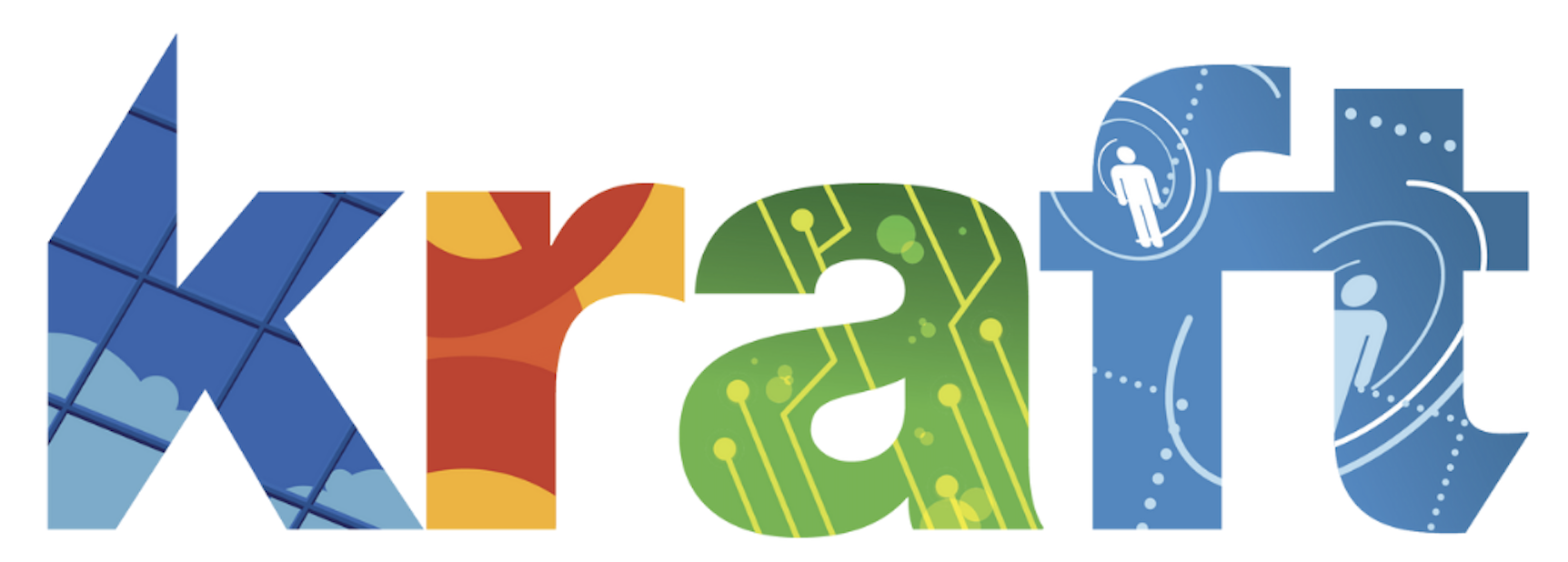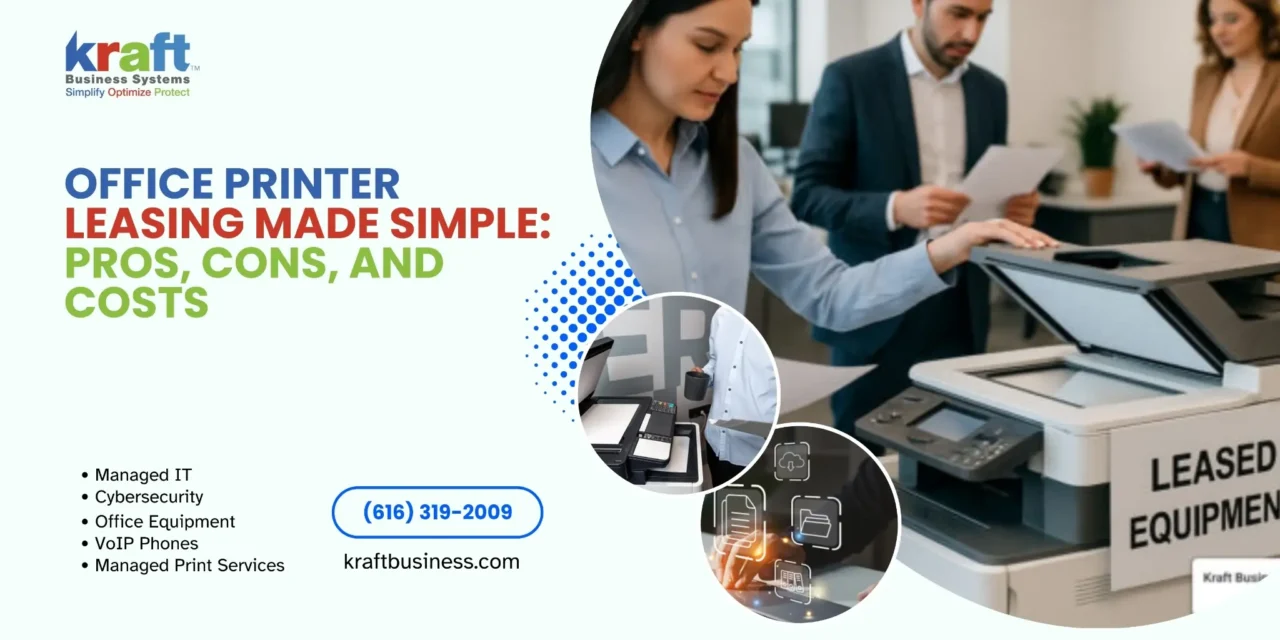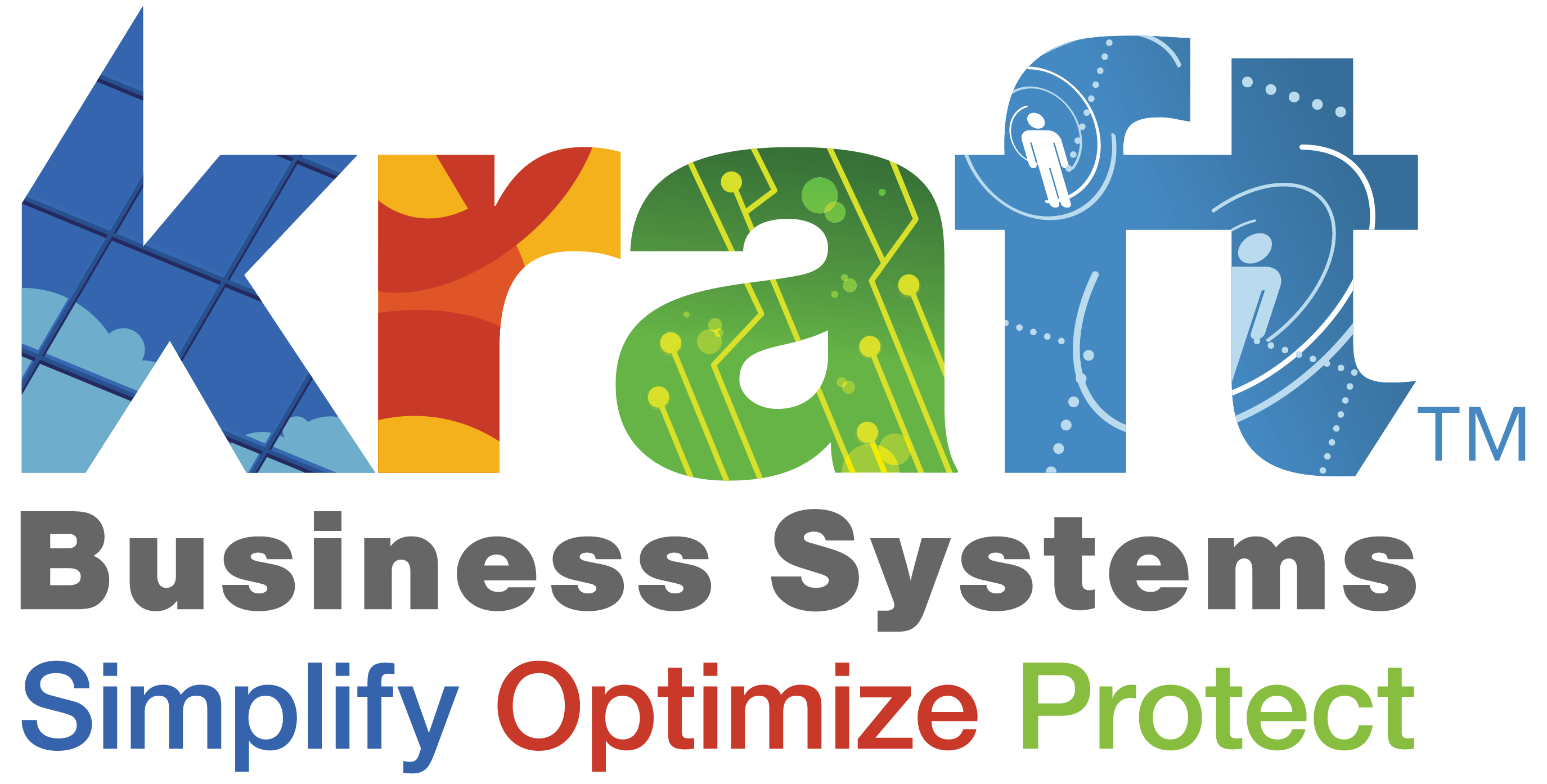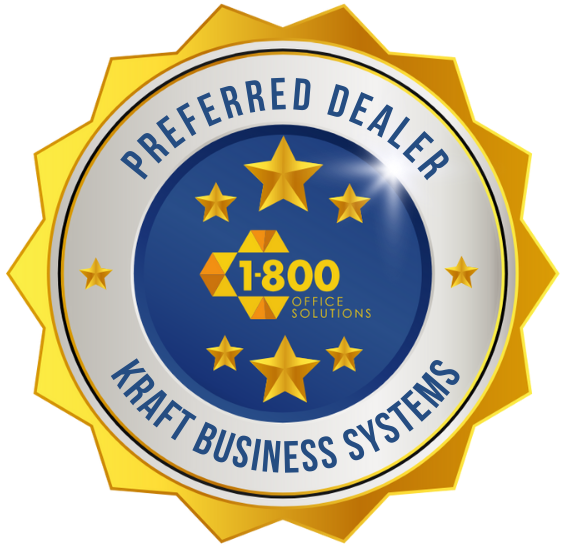Leasing office printers offers a flexible alternative to purchasing equipment outright. If you’re trying to decide between leasing or buying, here’s what you need to know:
- Leasing Pros: Lower upfront costs, predictable monthly payments, maintenance included, easy technology upgrades
- Leasing Cons: Higher total cost over time, contract restrictions, potential overage fees
- Best For: Businesses wanting to preserve cash flow, access the latest technology, or avoid maintenance responsibilities
When considering whether to lease or buy office printers, your decision should depend on your specific business needs, budget constraints, and growth projections.
Printer leasing works like renting – you pay a monthly fee for the use of the equipment over a set period (typically 12-60 months). Most leases include maintenance, support, and sometimes even supplies like toner, making budgeting more predictable.
For many mid-sized businesses, leasing makes sense because it:
- Preserves capital for core business investments
- Provides access to better equipment than you might afford to purchase
- Includes technical support and maintenance
- Allows for easier upgrades as technology evolves
“Whatever your printing need, we’re here to make sure you’re ready for it,” as one provider notes – and leasing often provides the flexibility to meet changing requirements without large capital outlays.
The average copier lease ranges from $100-$900 monthly depending on equipment capabilities, with lower-volume machines available for less. These predictable payments help businesses manage cash flow while accessing technology that might otherwise be out of reach.

How Does Printer Leasing Work?
Think of leasing office printers like renting an apartment – you get all the benefits without the long-term commitment of ownership. It’s a straightforward arrangement where you make regular payments for using the equipment while someone else handles the headaches of maintenance.
Key Lease Types Explained
When you’re exploring printer lease options, you’ll typically come across these common arrangements:
Operating Lease (or Fair Market Value lease) gives you lower monthly payments and maximum flexibility. When your term ends, you can simply return the equipment, renew your lease with newer technology, or purchase it at the current market price. It’s perfect if you like staying current with technology without the hassle of selling outdated equipment.
Capital Lease(often called a $1 Buyout lease) works more like buying on an installment plan. Your monthly payments will be higher, but at the end, you can purchase the printer for just $1. This makes sense when you’ve found equipment you love and want to keep long-term.
Lease-to-Own options blend the two approaches, where your payments gradually build ownership equity. When the term ends, the printer is yours without additional payments.
Most businesses choose between short-term leases (12-24 months) for maximum flexibility, or long-term agreements (36-60 months) to secure lower monthly payments.

What’s Inside the Contract
A good printer lease doesn’t just provide equipment – it delivers peace of mind. Standard agreements typically include:
Professional delivery and setup that gets you running from day one. No more wrestling with complicated installation procedures or wasting valuable staff time.
Comprehensive maintenance keeps your equipment running smoothly, with technicians handling everything from routine cleaning to complex repairs.
Modern lease agreements have evolved to include smart features like remote monitoring that catches problems before they cause downtime, automatic toner shipments that arrive just when you need them, and guaranteed response times when issues do arise.
Many businesses appreciate the detailed usage reporting that helps track printing costs across departments – finally answering the age-old question of “who’s printing all those color documents?”
Leasing Office Printers and Contract Flexibility
The best part about leasing office printers is that you’re not locked into yesterday’s technology as your business evolves. Smart contracts include:
Early termination options (though be careful – penalties can sometimes be steep), buyout provisions if you fall in love with your equipment, and clear end-of-term choices so you know exactly what happens when your lease concludes.
Look for upgrade addendums that let you swap equipment mid-lease if your needs change. As one client told us, “Our business doubled in size during our lease term, but our contract let us upgrade to a higher-capacity model without starting over.”
Flexibility is especially valuable for growing businesses or those in rapidly changing industries. With the right lease agreement from Leasing a Printer for Business, your printing solution can evolve right alongside your company’s needs.
True Cost of Leasing vs Buying
When it comes to leasing office printers versus buying them outright, the true financial picture goes deeper than what first meets the eye. Let’s take an honest look at what each option really costs your business.

Capital Outlay vs. Monthly Payments
The most striking difference you’ll notice right away is how much cash leaves your account on day one:
With a purchase, you’re looking at writing a substantial check upfront. A quality office multifunction printer can range from $3,000 for basic models to a whopping $35,000+ for advanced systems. Most businesses end up spending around $13,000 for a solid mid-range machine that handles about 55 pages per minute.
With a lease, that same equipment might cost between $65 and $900+ monthly, depending on the capabilities you need. This dramatic difference in initial investment explains why many growing businesses prefer to preserve their working capital through leasing.
As one business owner put it, “That $13,000 I didn’t spend on a printer funded our product development for three months.”
Hidden Costs to Consider
The story doesn’t end with the purchase price or monthly payment. Several factors affect what you’ll actually spend over time:
Cost-per-page adds up regardless of whether you own or lease. Toner, ink, and other consumables are ongoing expenses either way, though lease agreements often include better rates on these supplies.
Maintenance and repairs come with every printer. When you own the equipment, you’ll need separate service contracts or pay for repairs as they happen. Lease agreements typically bundle maintenance, saving you from unexpected repair bills.
Downtime costs might be the most expensive hidden factor of all. When printers fail, productivity suffers. Lease agreements with rapid response service minimize this impact, keeping your team working instead of waiting.
Depreciation hits purchased equipment hard. That $13,000 printer might be worth just a fraction of its original value in three years, while leased equipment is simply returned with no loss of investment.

Tax Considerations
The financial picture isn’t complete without understanding how each option affects your taxes:
Leased equipment payments are typically fully deductible as business expenses each month, simplifying your accounting and providing predictable tax benefits.
Purchased equipment follows depreciation schedules, though Section 179 deductions may allow for full expensing in the first year (up to certain limits). This can create a significant upfront tax advantage, but requires more complex accounting.
“Under IRS Section 179, purchased printers can be fully expensed in the first year, offering significant tax savings,” notes one tax expert. However, this single advantage must be weighed against the numerous benefits of leasing.
For a deeper dive into why many businesses choose leasing over buying, check out our detailed analysis on Leasing Over Buying Printers.
The cheapest option on paper isn’t always the most economical in practice. When you factor in the value of flexibility, technical support, and avoiding technology obsolescence, leasing office printers often provides the better overall value for growing businesses.
8 Major Benefits of Leasing vs Buying

When you’re weighing your options, the benefits of leasing office printers go far beyond simple dollars and cents. Let me walk you through the advantages that make leasing an attractive choice for many businesses.
Think about predictable cash flow – those fixed monthly payments make budgeting a breeze compared to the surprise expenses that can come with ownership. You know exactly what you’ll spend each month, which helps your financial planning tremendously.
Perhaps my favorite benefit is access to the latest technology. Rather than being stuck with that aging printer that’s becoming increasingly outdated, you can simply upgrade to newer models when your lease ends. Technology moves quickly, and leasing helps you keep pace.
The bundled support and maintenance that comes with most leases is a game-changer. When something goes wrong with a printer you own, that service call comes straight out of your pocket. With a lease? It’s typically included, eliminating those unexpected repair costs that can throw off your budget.
As your business grows, scalability becomes crucial. Leasing makes it easy to add or upgrade equipment without major capital investments. Your printing capabilities can grow right alongside your business needs.
There are potential tax advantages too. Those lease payments are typically fully deductible as business expenses, which can simplify your tax planning compared to managing depreciation schedules for purchased equipment.
By leasing, you’re also practicing smart financial management through conservation of credit lines. Why tie up your business credit on depreciating assets when you could preserve it for strategic investments that drive growth?
Your IT team will thank you for the reduced IT burden that comes with comprehensive service agreements. Instead of troubleshooting printer issues, they can focus on more strategic technology initiatives that move your business forward.
Lastly, don’t overlook the sustainability benefits. Leasing companies typically handle proper disposal and recycling of old equipment, reducing your environmental footprint and helping you meet corporate sustainability goals. Check out more about these advantages in our guide to Top Printer Leasing Benefits.
How Maintenance Bundles Slash Downtime
One of the most valuable aspects of leasing office printers is the comprehensive maintenance packages that keep your business running smoothly.
With remote diagnostics, many problems can be identified and sometimes even resolved without a technician ever setting foot in your office. This means less waiting and more productivity for your team.
The proactive maintenance included in most leases prevents issues before they cause downtime. Regular service checks catch potential problems early, saving you from the frustration of mid-project breakdowns.
Lease customers typically receive priority service response – you’re at the front of the line when you need help, unlike pay-per-call clients who might wait longer for assistance. When productivity is on the line, this priority treatment is invaluable.
And let’s not forget automated supply management – systems that monitor toner levels and automatically ship replacements before you run out. No more emergency supply runs or printing delays due to empty toner cartridges!
Leasing Office Printers and Upgrade Cycles
Leasing office printers provides a natural technology refresh cycle that perfectly aligns with the typical 3-5 year lifespan of business printers.
The swap-out options in many leases allow for equipment upgrades mid-term if your needs change. Maybe you suddenly need color printing capabilities, or your print volume increases dramatically – leasing gives you the flexibility to adapt.
Many providers offer mid-term refresh opportunities that update your technology during the lease without restarting the contract. This means you’re never stuck with outdated equipment for the entire lease term.
Perhaps most importantly, leasing provides protection from obsolescence. Security features that were cutting-edge just a few years ago may now be considered basic requirements. With leasing, you’re never left with technology that can’t handle newer software or security protocols.
The business world moves fast, and your printing technology needs to keep up. With leasing office printers, you’ll always have equipment that meets your current needs – not technology that was great three years ago but struggles with today’s demands.
How to Choose the Right Printer to Lease
Selecting the right equipment is crucial to maximizing the benefits of leasing office printers. Here’s how to match your needs with the right device:

Key Factors to Consider
Finding your perfect printer match doesn’t need to be complicated. Start by thinking about your monthly print volume – are you printing under 3,000 pages per month or churning out 20,000+ pages? This single factor dramatically narrows your options.
Color capability is another big decision point. While color printing costs more, it might be essential if you regularly produce marketing materials or client presentations. Many businesses find a mix of color and monochrome printers provides the best balance of functionality and cost.
Multifunction printers (MFPs) have become increasingly popular because they combine printing, scanning, copying, and sometimes faxing in one space-saving device. For most offices, these versatile machines make more sense than dedicated single-function printers.
Speed matters too, especially in busy environments. Printer speeds range from about 20 pages per minute for basic models to 75+ ppm for high-volume workhorses. Nothing frustrates employees more than waiting at the printer, so be honest about your needs here!
Don’t overlook security features when selecting your printer. Modern business printers should include secure print release, user authentication, and data encryption. These protections are no longer optional in a world where even printers can be cybersecurity vulnerabilities.
The ability to print from smartphones, tablets, and cloud storage has moved from “nice-to-have” to “must-have” status. With remote and hybrid work becoming standard, mobile printing capability ensures everyone can print what they need, when they need it.
Before finalizing your selection, measure your available space. There’s nothing worse than leasing the perfect printer only to find it won’t fit in your office!
Match Features to Business Size
Small businesses with 1-10 employees typically need compact multifunction devices with speeds around 20-35 ppm. These teams usually print under 5,000 pages monthly and benefit from Wi-Fi connectivity for flexible placement.
Mid-sized organizations (11-100 employees) often require departmental systems running at 35-45 ppm to handle 5,000-15,000 monthly pages. These businesses typically need network integration and may benefit from finishing options like stapling.
Large enterprises with over 100 employees generally need high-volume systems capable of 45-75+ ppm speeds and 15,000+ monthly pages. Advanced security features and enterprise software integration become critical at this scale.
Home and remote offices have unique needs focusing on reliability and ease of use. Cloud connectivity for remote management is particularly valuable, allowing IT support without on-site visits. These setups benefit from low-maintenance systems that don’t require frequent attention.
Budget-Friendly Tips & Negotiation Hacks
Smart negotiation can dramatically improve the value of your printer lease. Bundle supplies with your lease whenever possible – including toner in your agreement typically costs less than purchasing separately and simplifies budgeting.
Color printing costs add up quickly, so negotiate caps based on your actual needs. Many businesses overestimate their color requirements and end up paying for capacity they never use.
Don’t be afraid to request staggered payments if cash flow is tight initially. Many providers will structure payments to start lower and increase gradually as your business grows.
Always get multiple quotes before signing any lease. Having competitive options not only gives you negotiating leverage but also helps you understand the full range of available features and pricing structures.
Consider asking about certified refurbished equipment, which often provides like-new reliability at significantly lower rates. Many businesses are surprised by the quality and warranty protection available with these options. Check out our guide on Cheap Printer Lease options for more money-saving ideas.
When to Upgrade or Switch Mid-Lease
Business needs evolve, sometimes faster than expected. If your print volumes significantly increase or decrease, your current equipment might no longer be the right fit. Equipment that’s too small struggles with high volume, creating bottlenecks, while oversized equipment costs more than necessary.
New functionality requirements often trigger mid-lease upgrades. Perhaps your business suddenly needs advanced scanning capabilities or finishing options your current device lacks. Rather than waiting until your lease ends, explore your upgrade options.
Leasing office printers provides flexibility when security requirements change. New compliance mandates might necessitate upgraded security features that weren’t available when you signed your original lease.
Persistent reliability issues, despite proper maintenance, are a clear signal that it’s time for different equipment. Excessive downtime costs far more in lost productivity than the cost of upgrading.
Most lease agreements include provisions for equipment upgrades through “rollover clauses” or “refresh windows.” These allow you to transition to new equipment by incorporating the remaining lease obligation into a new agreement. Check out our detailed guide on Best Printers to Lease for Office to see what current models might be worth upgrading to.
The right printer lease should evolve with your business needs, not restrict them. When considering your options, the goal isn’t just acquiring equipment – it’s supporting your business workflows in the most efficient way possible.
Leasing Office Printers: Pros and Cons
When weighing your options for office equipment, it’s important to look at both sides of the coin with leasing office printers. Let’s explore what works well and what might give you pause:

Pros of Leasing
Printer leasing offers several compelling advantages that make it attractive for many businesses. Predictable monthly payments make budgeting a breeze – you’ll know exactly what to expect each month without surprise expenses throwing off your financial planning.
Perhaps the most immediate benefit is the minimal upfront investment required. Rather than writing a large check that depletes your available cash, you can preserve that capital for growing your business or handling unexpected opportunities.
Most lease agreements come with comprehensive maintenance and support bundled in. This means when something goes wrong (and eventually, something always does with printers), you’re not scrambling to find a technician or facing unexpected repair bills.
Technology moves quickly, and with a lease, you enjoy easy technology upgrades when your term ends. No more being stuck with outdated equipment that can’t handle modern security requirements or workflow needs.
Many businesses appreciate the potential tax advantages too. Unlike purchased equipment that must be depreciated over time, lease payments are typically fully deductible as business expenses in the year they’re paid (though always consult your tax professional).
Your IT team will thank you for the reduced technical burden that comes with leased equipment. Instead of troubleshooting printer problems, they can focus on more strategic initiatives that drive your business forward.
Cons of Leasing
Of course, leasing isn’t perfect for every situation. The higher long-term cost is perhaps the most significant drawback – if you add up all payments over the lease term, you’ll typically pay more than the purchase price of the equipment.
With standard leases, you build no ownership equity – at the end of the term, you don’t own anything unless you exercise a purchase option (which may be available depending on your lease type).
The contract lock-in aspect makes some business owners uncomfortable. Early termination usually comes with significant penalties, which can be problematic if your business needs change dramatically.
Many leases include volume restrictions with overage fees that kick in when you exceed your allotted print volume. These can add up quickly if your printing needs aren’t properly assessed upfront.
When your lease ends, you’ll need to return equipment in good condition, potentially facing return condition charges if the printer shows excessive wear and tear. And watch out for automatic renewal clauses that can extend your commitment if you don’t provide notice within a specific timeframe.
Mitigating the Downsides
The good news is that with some planning, most of these drawbacks can be managed effectively.
To address higher long-term costs, shop around for competitive rates from multiple providers and consider lease-to-own options if you plan to keep the equipment long-term. The right lease structure can significantly reduce the cost difference compared to purchasing.
Combat contract inflexibility by negotiating terms upfront that allow for changes as your business evolves. A good lease agreement should include specific upgrade provisions and reasonable exit options.
For usage limits and overage concerns, start by accurately assessing your actual print volumes before signing. Work with your provider to negotiate reasonable caps on overage charges and implement print management software to monitor and control usage throughout your organization.
As one of our Grand Rapids clients recently shared, “The fine print matters more than the monthly payment. We negotiated terms that let us upgrade mid-lease when our needs changed, and it saved us thousands.” This highlights an important point—the standard contract is just the starting point for negotiation.
Working with a provider who understands your specific business needs makes all the difference in crafting a lease agreement that protects your interests while delivering the benefits of leasing office printers without unwanted surprises.
For businesses looking to optimize their print environment while maintaining flexibility, our Managed Print Services can provide an additional layer of oversight and cost control beyond basic leasing.
Frequently Asked Questions about Leasing Office Printers
Is leasing a printer more cost-effective long term?
When it comes to pure dollars and cents, buying a printer outright usually costs less if you:
- Plan to use the equipment for its full 5+ year lifespan
- Don’t need to upgrade technology frequently
- Have money available for the upfront purchase
- Can handle maintenance and service issues yourself
But the real-world math often favors leasing office printers when you consider:
The value of keeping your cash free for things that actually grow your business. As many business owners tell us, “Cash is king, especially when opportunities arise.”
The hidden costs of printer downtime. When your owned printer breaks down, every hour waiting for repairs costs you in productivity.
The hassle factor of managing maintenance schedules and supply orders yourself. Your time is valuable—shouldn’t it be spent on your core business?
The productivity boost from having current technology. Technology changes quickly, and leasing helps you keep pace.
“Buying almost always costs less on paper and gives you an asset to resell,” explains one financial advisor we work with. “But leasing preserves your cash flow and offers predictable monthly expenses.” Your best choice depends on what matters most to your unique business situation.
Can home offices qualify for business-grade leases?
Absolutely! With remote work becoming the new normal, home office leasing options have expanded tremendously.
Good news for Michigan’s remote workers: you don’t need a corporate headquarters to get professional equipment. Many of our home-based clients in Grand Rapids, Detroit, and across the state are surprised to learn they can lease the same quality equipment as larger offices.
Here’s what makes home office leasing work:
Most leasing companies now offer programs specifically designed for remote workers. Qualification typically requires decent credit and proof that you’re running a legitimate business.
Lease terms tend to be more flexible than traditional office arrangements, with options ranging from compact desktop models to full-featured business machines that can handle serious workloads.
The right business-grade printer can dramatically boost your productivity at home—without requiring a huge upfront investment or technical expertise.
How do equipment changes work before the lease ends?
Need to swap equipment mid-lease? It happens more often than you might think, and there are several ways to make it work:
Built-in upgrade provisions are your best friend. Many quality leases include terms that allow for technology upgrades after you’ve completed part of your lease (often 24-36 months into a longer agreement).
Lease restructuring lets you roll your existing lease into a new agreement. This extends your overall commitment but gets you into new equipment when you need it.
Buyout options allow you to purchase the remaining lease obligation (usually at a discount) and start fresh with new equipment that better suits your needs.
Add-on leases let you keep existing equipment while adding new devices as your needs grow.
The key is working with a provider who sees themselves as your partner, not just your vendor. As one of our leasing specialists likes to say, “The best lease agreements grow with your business rather than holding it back.”
What happens at the end of a printer lease?
As your lease term wraps up, you’ll typically have four main options:
Return the equipment by simply handing back the printer in good working condition. Normal wear and tear is expected, but significant damage may incur charges.
Renew your lease with the same equipment at a reduced monthly rate. This makes sense if the technology still meets your needs.
Upgrade to new equipment by starting a fresh lease with newer technology. This is the most popular option among our clients who want to stay current.
Purchase the equipment at either fair market value or a predetermined price, depending on your lease type. Some businesses prefer this option if the printer has proven reliable and still meets their needs.
Most reputable leasing companies (including Kraft Business Systems) will reach out 3-6 months before your lease expires to discuss your options. This gives you plenty of time to make the right decision without feeling rushed or getting stuck with automatic renewals.
Planning ahead is crucial—we’ve seen too many businesses scramble at the last minute because they didn’t realize their lease was ending. Mark your calendar now to avoid that stress later!
Conclusion
Leasing office printers offers a flexible, budget-friendly path for businesses that value predictable expenses without large capital outlays. Think of it as the difference between renting an apartment versus buying a house – each has its place depending on your situation and goals.
While leasing typically costs more than buying over the long haul, the included maintenance, technical support, and upgrade options deliver tremendous value beyond just the hardware itself. For many Michigan businesses, these benefits far outweigh the higher total cost when you consider the peace of mind that comes with predictable monthly expenses.
Finding the right balance between your current needs and future flexibility is the real key to successful printer leasing. By carefully assessing your print volumes, feature requirements, and growth projections, you can structure an agreement that supports your business goals without unnecessary expenses or constraints.
Here at Kraft Business Systems, we know that every business across Michigan has unique printing needs and challenges. Our team of experts throughout Grand Rapids, Detroit, Traverse City and beyond can help you steer the sometimes confusing world of printer leasing to find the perfect solution for your organization.
We’ve seen how the right printing solution can transform workflow efficiency for our clients – whether it’s a small professional office or a large manufacturing operation. The right equipment paired with the right service agreement can make all the difference in your day-to-day operations.
Ready to explore how printer leasing might benefit your business? Our consultants can help you assess your needs, compare options, and structure an agreement that delivers maximum value for your specific situation. Contact us today to learn more about our comprehensive printer and copier solutions.
